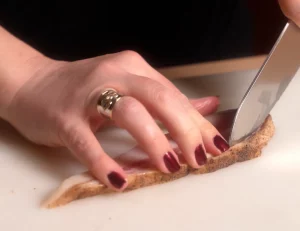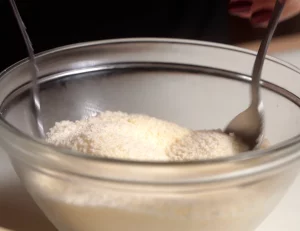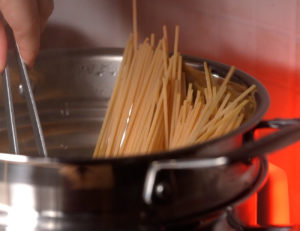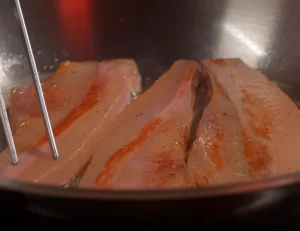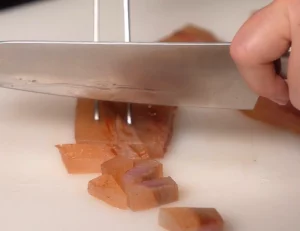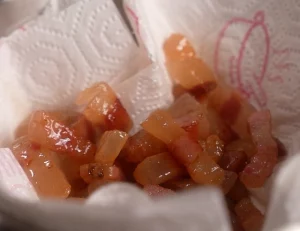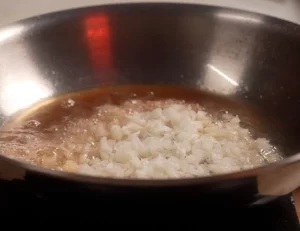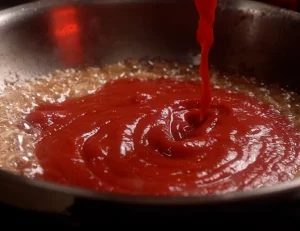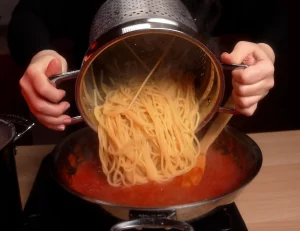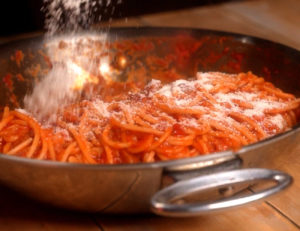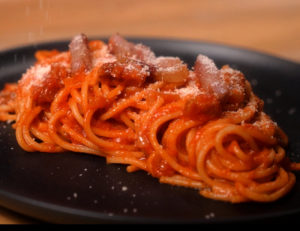Pasta Amatriciana recipe is one of the pillars of Roman pasta, along with: Spaghetti Carbonara, Spaghetti Cacio e Pepe and Pasta alla Gricia! With fine Italian guanciale, tomato and pecorino cheese—you’ll love this dish!
In our other Pasta Amatriciana recipe, we share the official recipe published by the Amatrice Chamber of Commerce in Italy with spaghetti, guanciale, white wine, olive oil, red pepper, tomato and pecorino cheese. It is tasty, but we agree with the critics that these city officials made a few deviations that many Romans would disagree with. So, here we present another very traditional take on the Pasta all’Amatriciana that is still considered authentic by most Romans in Italy. Keep reading!

This Recipe is In Our Cookbook!
Pasta Affair: 50 Authentic Italian Recipes
Seductive strands of pasta and sumptuous sauces… Are you ready to indulge in an unforgettable Pasta Affair? It’s the best pasta cookbook for beginners and a must-have for any serious lover of Italian food, featuring over 50 classic pasta recipes you can make at home!
Watch the Video Recipe!
Watch Flavia Diamante prepare this Pasta Amatriciana recipe in our video, filmed in Italy:
Subscribe to our YouTube Channel
More video recipes? Subscribe to our YouTube Channel (it’s FREE) and click the bell to get notifications when we release a new video recipe!
Pasta Amatriciana: FAQ
Like many Italian pasta recipes, there are definitely wrong ways to make Pasta Amatriciana or Spaghetti Amatriciana (or Pasta all’Amatriciana in Italian). However, there are a few right ways to make the dish without offending (most) Romans. Here are some frequently asked questions and points of debate to consider when making Pasta Amatriciana.
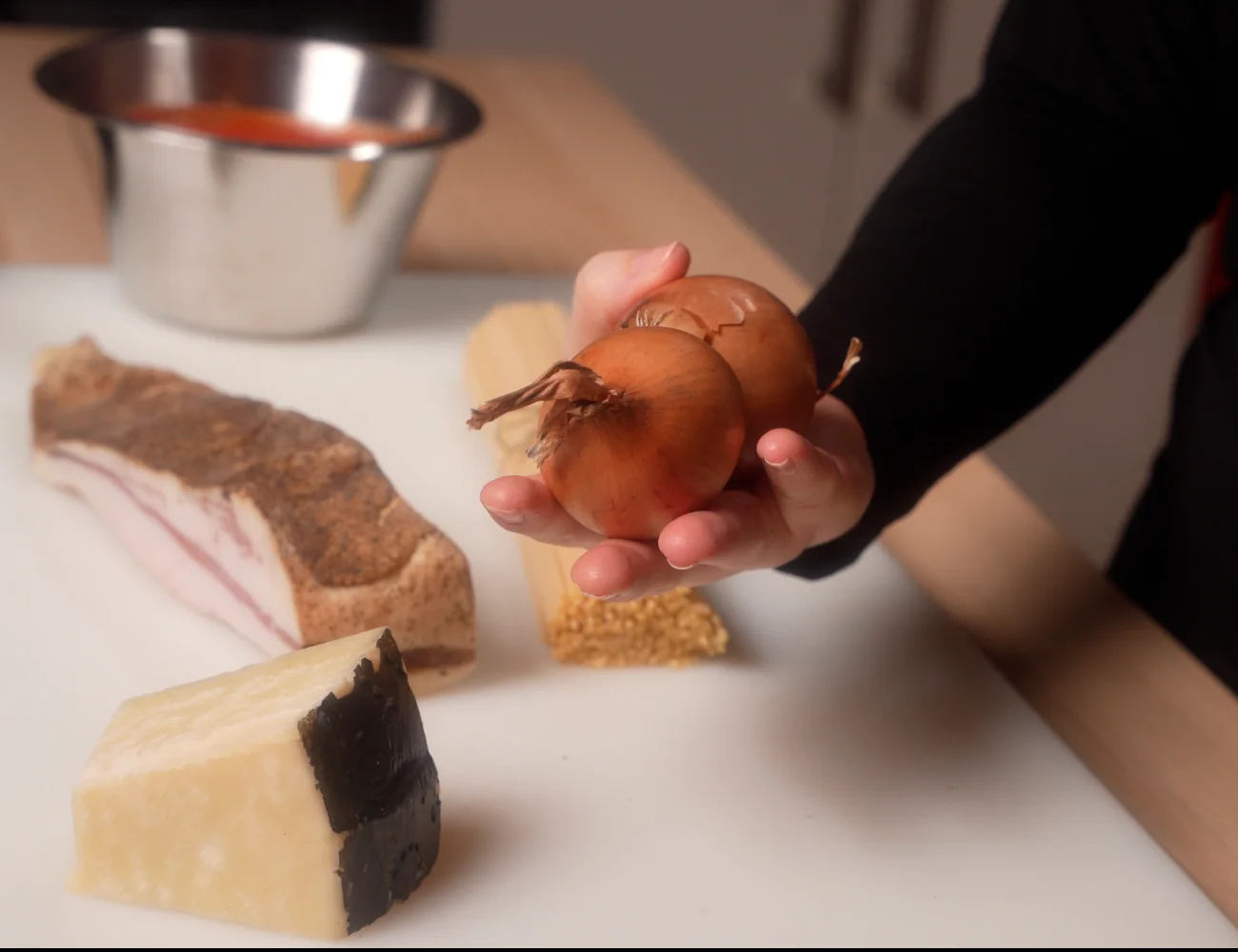
Guanciale or Pancetta? Choose Guanciale
In Italy, guanciale is the cured pork of choice for Spaghetti Carbonara, Pasta alla Gricia and Spaghetti Amatriciana! And no, guanciale is not the same as pancetta and pancetta is not the same as American ‘bacon.’ Here’s a quick rundown:
- guanciale: cured pork cheek
- pancetta: cured pork belly
- bacon: smoked cured pork belly (or sometimes made from other cuts)
Guanciale has a different taste then pancetta or bacon. It also tends to give off more fat then pancetta. That is particularly desired in these traditional Roman pasta recipes where the guanciale grease is used to flavor the pasta and sauce.
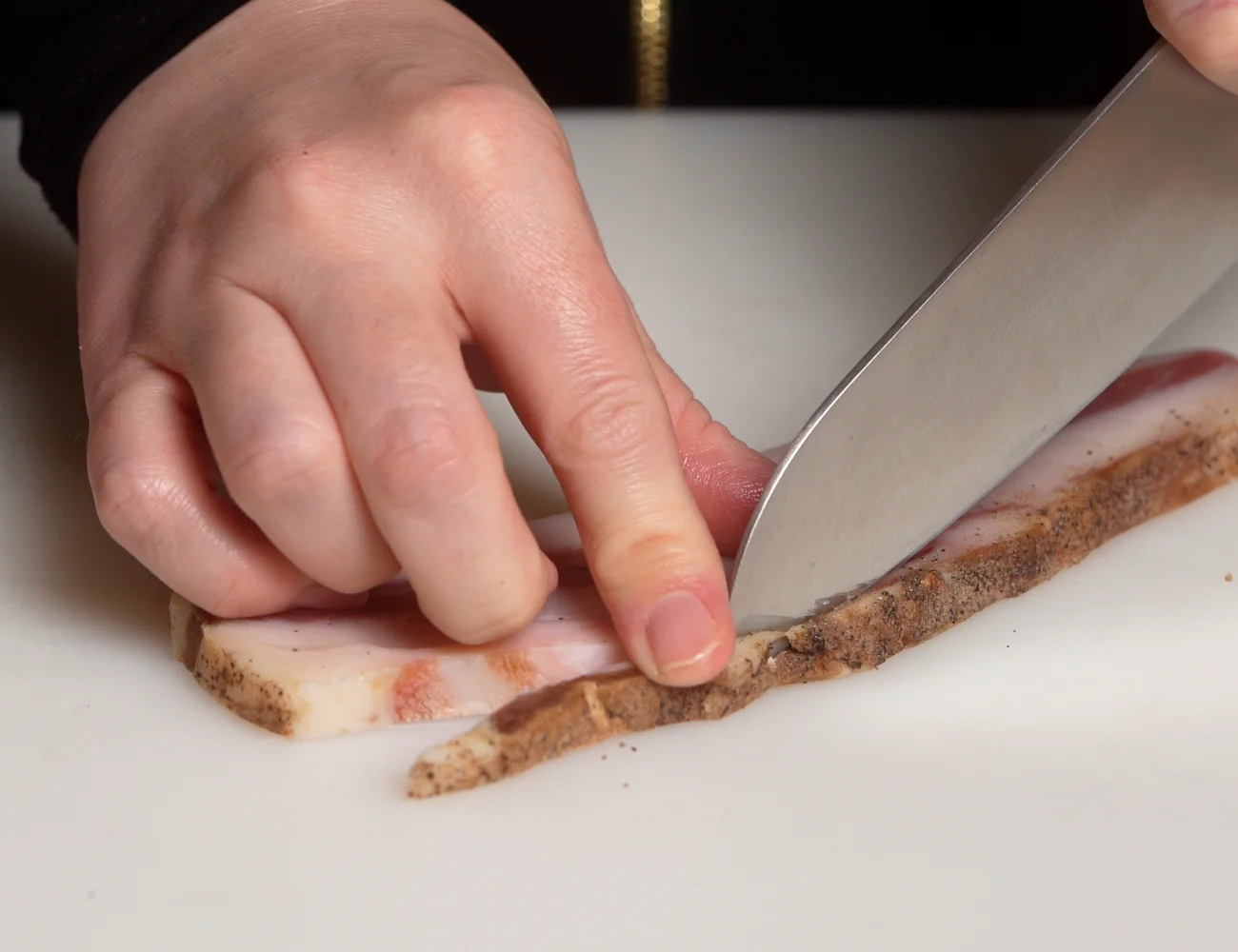
Onions? Yes!
Onions are a wild card in Pasta Amatriciana recipes. Many Romans and Italians put it in this dish. The official authentic Pasta Amatriciana recipe endorsed by the city of Amatrice doesn’t include it. We like the flavor it imparts to the sauce and it’s so commonly used, we think it is perfectly acceptable to add it. Leave it out if you disagree.
Olive Oil? No!
When we presented the recipe official authentic Pasta Amatriciana recipe endorsed by the city of Amatrice in our other PIATTO video recipe, many Romans and Italian chefs complained. In our defense, we were presenting that recipe. However, we agree with the critics on one big point: there is no reason to put olive oil in this recipe. Guanciale gives off a tremendous amount of tasty grease—perfect for sautéing the onion and flavoring the pasta sauce. It’s madness to add additional fat. So, in this recipe, we don’t include additional olive oil.
Another argument in favor of leaving out the olive oil? As a poor man’s recipe, most families would have used the more widely available animal fat in this dish rather than the more expensive olive oil. And while we are all for de-glazing pans with wine, the water in the tomato will do the job here. So, we’ve left out the white wine in this recipe.
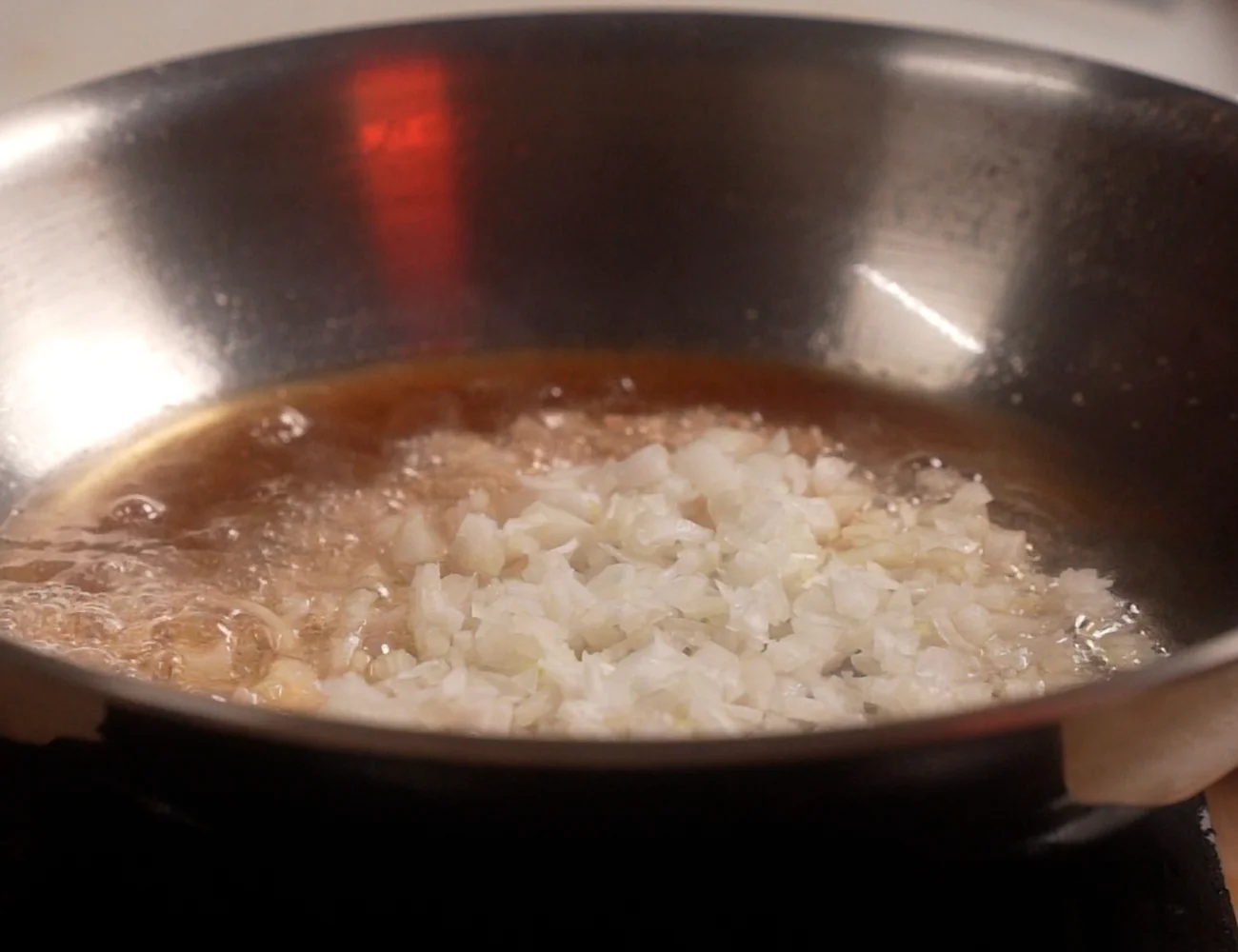
Tomato: How to Achieve a Sweet Tomato Sauce
Outside Italy, so-called Italian recipes are full of tips on reducing the acidity in tomato sauce. That’s largely because many home cooks struggle to access quality sweet tomato products or don’t know which brands and products to choose. Please see our article on Best Canned Tomatoes for Sauce for more on this topic.
In short, choose quality tomato products to start with. Look for products that say they are ‘Made in Italy’ with San Marzano tomatoes—renowned for their sweet and delicious flavor. Never buy ‘tomato pulp’ or ‘crushed tomato’ in a can. Many traditional Italian recipes instruct you to buy whole canned tomato (or use fresh whole tomatoes), remove the water, then blend the flesh into a pulp. This is because Italians know that many ‘crushed’ and ‘pulp’ products include the skin and water of the tomatoes which contribute to acidity.
That’s why in this recipe we combine our favorite ‘Made in Italy’ tomato purée with a bit of whole canned tomato blended to a rough pulp with a blender, fork, or similar (affiliate link). This creates a super sweet tomato sauce that does not require any added sugar or (god-forbid) baking soda to reduce the acidity.
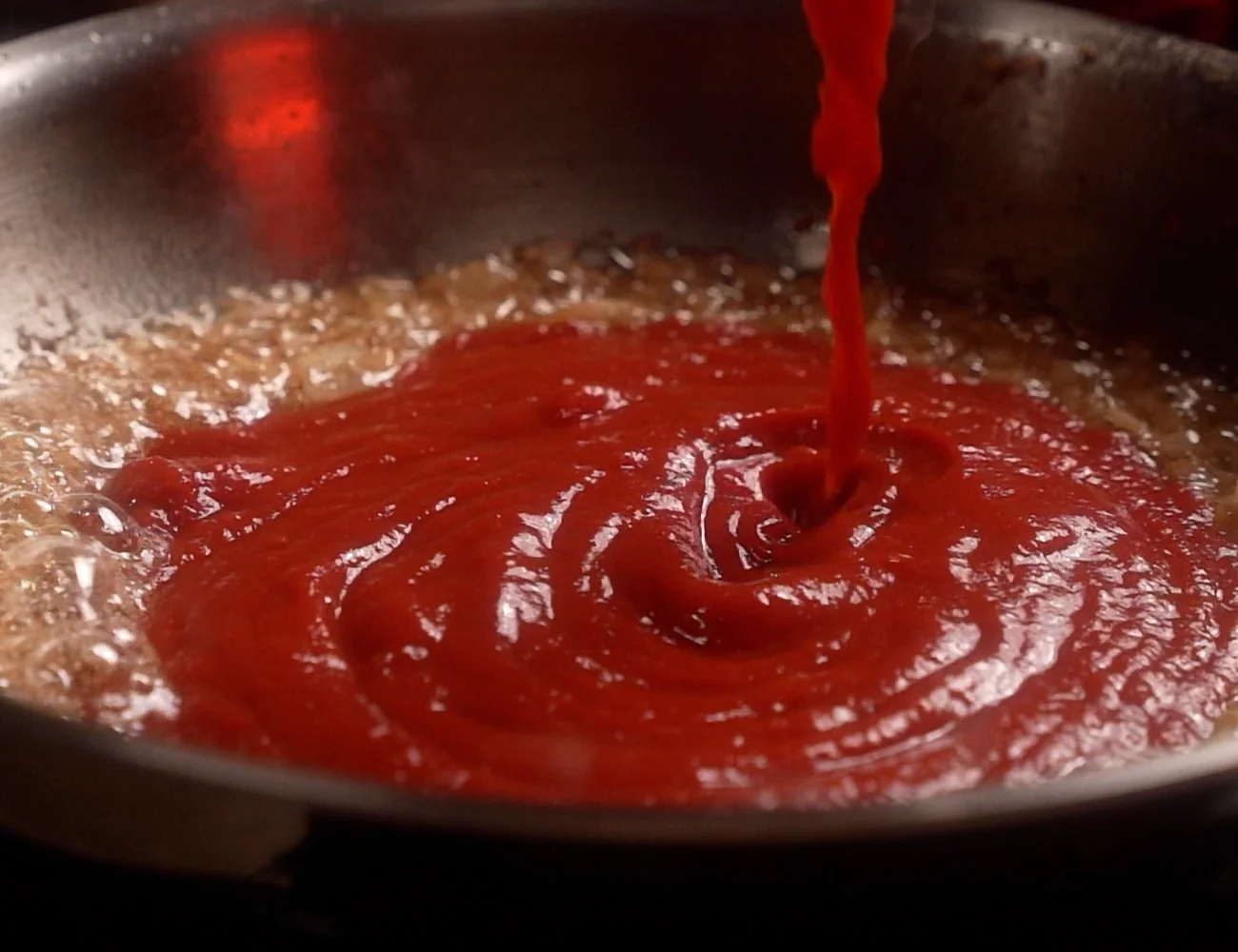
Pecorino: Which Kind?
Many non-Italians are surprised to discover there is not just one pecorino cheese in Italy. While Pecorino Romano (pecorino from Rome) is the most famous abroad, there are in fact pecorino cheeses from many regions of Italy. Each of these pecorino cheeses are made locally and have their own unique taste.
Here, it is just fine to use a finely grated Pecorino Romano cheese. This dish bears the name ‘Amatrice’ which is a small town near Rome and, yes, they do technically have a cheese that bears their name. You can certainly use that if you can find it. But most Romans and Italians would consider the flavor identical since both of these cheeses are from the same region in Italy.
Now, we would not say that about every pecorino… Pecorino Sardo (from Sardegna) and Pecorino Toscano (from Tuscany) in our view do have a different taste. Each unique and delicious.
Use semi-aged cheese for Pasta Amatriciana if you can simply because it melts easier.
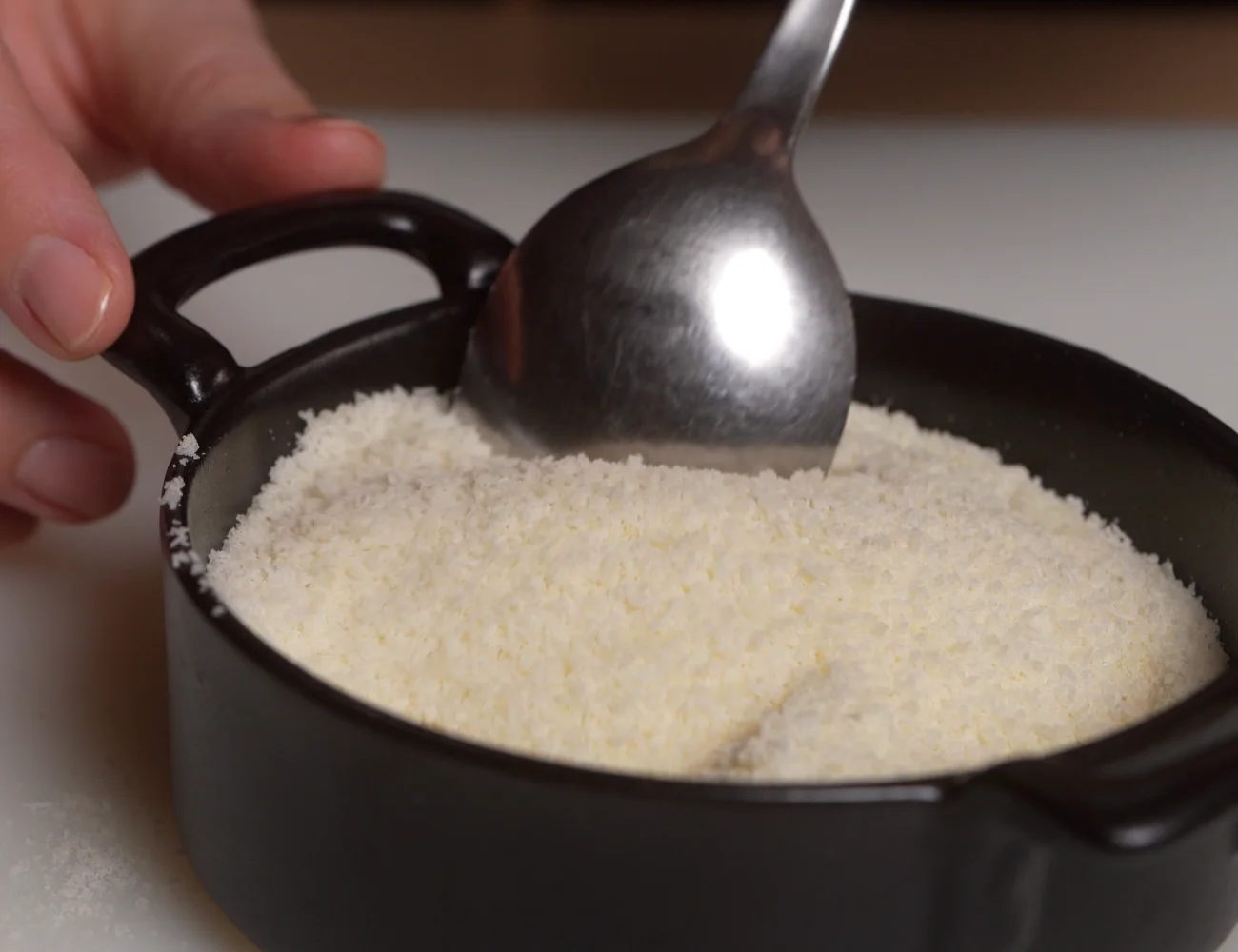
Spaghetti… Tonnarelli or Bucatini?
Any of these pastas can reasonably used to make Pasta Amatriciana. Spaghetti is very common, though.
How to Make Pasta Amatriciana like an Italian
This (like most of the Roman pasta recipes) is a very fast dish. It can be ready in the time it takes to cook the pasta. So, start by putting the pasta on to boil for 3/4 of the time called for on the package instructions to make the pasta al dente. We will finish cooking the pasta in the pan. Add salt to the pasta water, but a bit less than you normally would. The pecorino and the guanciale in this pasta recipe are already very salty.
While the pasta is boiling, cook the guanciale over medium-low heat until the fat is tender and translucent and the meat is crispy. We want the guanciale to be succulent inside, crispy outside. These days, we prefer to cook the guanciale in thick slices to cook it through fast and homogeneously. Then we cut the guanciale into strips and pass it back in the pan for a minute or so to crispy up.
After removing the perfectly-cooked guanciale from the pan (we’ll add it back later), sauté the onions in the grease until tender. Then add the tomato sauce, a pinch of red chili pepper to taste and finally the cooked and drained pasta. Finish cooking the pasta to al dente in the sauce (yes, Italians always eat their pasta al dente). Finally, add the guanciale back to the pasta, along with the finely grated pecorino cheese (off the heat). Serve! It’s that easy 🙂

As an Amazon Associate, we earn from qualifying purchases. This means at no extra cost to you, PIATTO may earn a small commission if you click the links and make a qualifying purchase.
Pasta Amatriciana with Onions – Authentic Recipe
Equipment
- 1 Large Pot for cooking the pasta
- 1 Large Skillet
Ingredients
- 7 oz guanciale
- 1 ½ small onion minced
- 7 oz whole canned tomatoes water and seeds removed; crushed into a pulp
- 18 oz tomato purée 'passata'
- ½ tsp ground red pepper or to taste
- 3 ½ oz pecorino romano cheese finely grated
- 1 pinch fine salt if needed, or to taste
- 14 oz spaghetti or bucatini
Instructions
Prepare the Ingredients
- Remove the outer pepper layer from the guanciale (if still there). Cut the guanciale into thick slices.

- Finely grate the pecorino cheese. Mince the onions.Remove the water and seeds from the whole tomatoes, leaving only the tomato pulp. Mash or blend the tomato into a crushed tomato consistency (pulpy with some sauce) and mix this with the tomato purée.

Partially Cook the Pasta
- Boil the pasta in lightly salted water. Cook the pasta for ¾ of the amount of time recommended for ‘al dente’ pasta on the package directions.14 oz spaghetti

Fry the Guanciale
- In a dry skillet over medium-low heat, add the guanciale slices. Cook for a couple of minutes, flipping once to ensure a homogeneous cook.7 oz guanciale

- When the guanciale fat is soft, tender and translucent, cut the guanciale into strips (about 1 inch x 1/3 of an inch) and return the strips to the pan for about a minute until crispy outside.

- Remove the guanciale pieces and set them aside for later. Leave the guanciale grease in the pan. We will finish the dish in this pan. We want all that delicious guanciale grease to sauté our onions and flavor our tomato sauce!

Make the Sauce
- Add the minced onions to the hot guanciale grease. Sauté them until tender and translucent.1 ½ small onion

- Add the tomato sauce (purée + pulp) to the pan with the onions along with chili pepper to taste.½ tsp ground red pepper

Finish with Pasta
- Add the drained, cooked pasta to the sauce. Finish cooking the pasta to al dente in the sauce.

- Remove the pasta from the heat. Add the fried guanciale and the finely grated pecorino cheese. Serve!3 ½ oz pecorino romano cheese, 1 pinch fine salt

- Top with any remaining guanciale and another sprinkle of pecorino and…Buon appetito!



